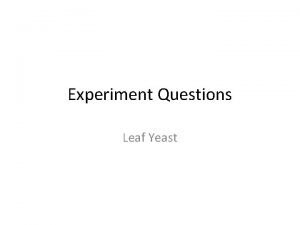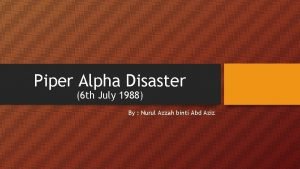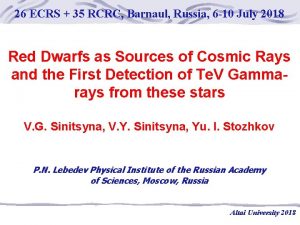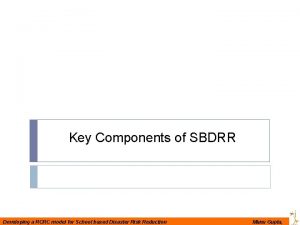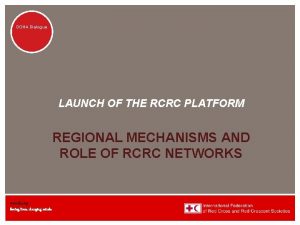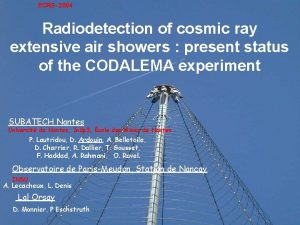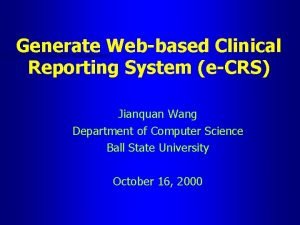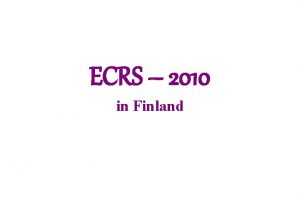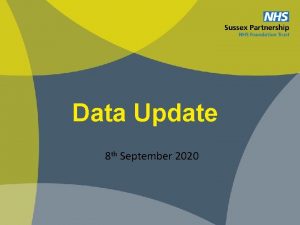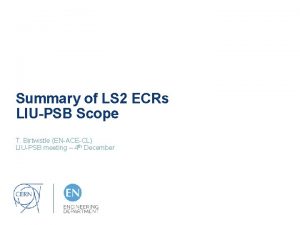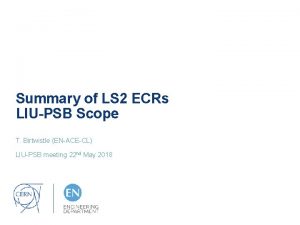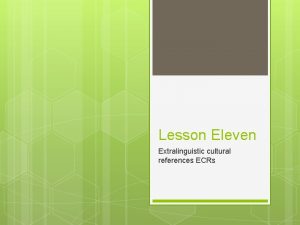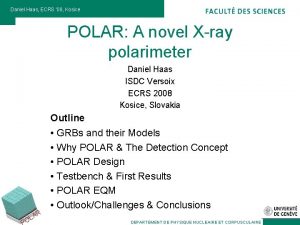26 th ECRS 35 th RCRC 06 July









































- Slides: 41

26 th E+CRS / 35 th RCRC 06 July 2018 - 10 July 2018 Altai State University Solar activity and cosmic ray variations in September, 2017 Makhmutov V. , Kalinin E. , Bazilevskaya G. , Philippov M. , Stozhkov Y. Lebedev Physical Institute RAS, Moscow

We present results of data analysis of solar activity and cosmic ray variations in September, 2017. This period characterized by the burst of the Solar flare activity on the background of the late decreasing phase of 24 th solar activity cycle. Solar protons were observed by the satellite based instruments, in the atmosphere and by the ground-based neutron monitor network. Also the significant Forbush-decrease was recorded with a number of instruments, for example - neutron monitors. Evaluation of energy spectra of solar protons

10 GLE 3 GLE Cycle 22: 1996 -07 -29 (X 2. 2), which produced the first- observed sunquake. Cycle 23: 2006 -12 -13 (X 3. 4), Cycle 24: 2017 -09 -06 (X 9. 3) 2017 -09 -10 (X 8. 2), both of which produced long-duration gammaray events (Fermi). “Spacings between the pairs of these three events of 10. 37 and 10. 74 years” (Hugh Hudson, RHESSI Science Nuggets, 306)

http: //cosrays. izmiran. ru/

6 -10 September 2017 5


The two longduration gammaray events observed towards the end of Cycle 24, courtesy the RHESSI Browser and [Fermi].

28 -OCT-2003 10 -SEP-2017 8

Integral p-fluxes GOES 13 1, 00 E+04 - Mirny - Apatity - NM 1, 00 E+03 1, 00 E+02 >10 Me. V 1, 00 E+01 > 30 1, 00 E+00 > 50 1, 00 E-01 > 60 September 2017 1, 00 E-02 10 11 12 13 14 15 16 > 100 Me. V

Cosmic rays in the atmosphere (Lebedev Physical Institute balloon measurements)

Apatity, Rc = 0, 65 Gv Preflight background belongs to GCR. X – atmospheric depth. Ep ≈ 100 Me. V

Mirny, Rc = 0, 03 Gv Counting rate of the fluxes of charged particles in the atmosphere. Flying height up to 25 -30 km.

NM - observations (nmdb. eu)

Short observation of ground based neutron monitors. 0. 10 0. 30 0. 65 3. 64 3. 84 6. 69

NM MOSCOW (IZMIRAN)

Thule R = 0. 30, Terre Adelie R = 0. 01 7 % Thule NM 6 5 Terre Adelie 4 3 2 1 0 -1 -2 -3 10, 5 10, 7 10, 9 11, 1 11, 3 September 2017 11, 5 11, 7 11, 9

Evaluation solar proton spectra

LPI balloon experiment, result of simultaneous measurements Mirny: 1 - 11 Sept. , 08: 31 -09: 22 UT 2 - 13 Sept. , 08: 52 -09: 15 UT 1 a 1 2 2 a Apatity: 1 a - 11 Sept. , 12: 34 -13: 07 UT 2 b - 13 Sept. , 12: 46 -13: 06 UT

E, Me. V J(>E), pfu

J(>E), pfu R 2 = 0, 9725 E, Me. V

TOM spectrum of Solar protons, 10 September 2017 1 E+04 1 E+03 1 E+02 G 13 1 E+01 NM PFU 1 E+00 1 E-01 1 E-02 1 E-03 1 E-04 1 E-05 1 E-06 10 100 E, Me. V 10000

SUMMARY We present results of data analysis of solar activity and cosmic ray variations in September, 2017. This period characterized by the burst of the SEP activity on the background of the late decreasing phase of 24 th solar activity cycle. Solar protons were observed by the satellite based instruments, in the atmosphere and by the ground-based neutron monitor network. Also the significant Forbush-decrease was recorded with a number of instruments, e. g. neutron monitors. Spectra of Solar protons were obtained: 10 -100 Me. V - y = 1248. 8 e-0. 04 E 100 -500 Me. V - y = 3 E+09 E-4. 0 > 500 Me. V - y = 1 E+19 E-7. 7

Thank you!

GOES + Stratosphere + NM data

NMDB network

10 September 2017, NMs


Solar flare activity in September, 2017 Säm Krucker , Hugh Hudson , RHESSI Nugget, 306, 11 September 2017: 2 major X-class flares in the waning phase of Solar Cycle 24. This happened in previous cycles: - Cycle 22: SOL 1996 -07 -29 (X 2. 2), which produced the first-observed sunquake. - Cycle 23: SOL 2006 -12 -13 (X 3. 4), with its white-light continuum remarkably well documented by [Hinode] (Ref. [2]). - Cycle 24: ended Cycle 24's major flare activity with SOL 2017 -09 -06 (X 9. 3) SOL 2017 -09 -10 (X 8. 2), both of which produced long-duration ɣ-ray events observed by Fermi.

Remarkably, the spacings between the pairs of these three events were similar to the recent mean solar-cycle duration of 11. 1 years (at separations of (10. 37 and 10. 74 years, respectively, shorter by only a few percent). While not very significant, these spacings are eerie - in each of the last three cycles, a "last best" event has happened, and at almost exact intervals. RHESSI Observation: RHESSI got excellent observations of SOL 2017 -09 -10, as illustrated in Figure 1. The flare was almost exactly at the limb, apparently such that one ribbon was entirely occulted and the other partially so, but still nicely showing both white-light flare continuum and hard X-rays with the same precise coincidence seen in events on the disk, confirming the 3 D nature of this identification. Figure 1: Imaging observations of SOL 2017 -09 -10 at high resolution. Upper panel, comparisons of RHESSI hard X-rays with the HMI white-light flare observation (footpoint); bottom panel, same RHESSI images compared with AIA 193 Å (looptop). This flare also produced a textbook example of CME ejection and the generation of a global wave. Figure 2 illustrates the canonical plasmoid/current-sheet pattern most clearly, with the very linear current-sheet EUV enhancement pointing straight at the loops seen by RHESSI and AIA. Figure 2: SOL 2017 -09 -10 produced a massive, fast CME, and in its wake this textbook-clear example of plasmoid and current sheet trailing it. Note the beautiful diffraction spikes produced by AIA's grids. This can be exploited in principle to increase the image dynamic range and also to provide spectral information.









10. 09. 2017 http: //nasa. com


Outline - peculiarities of solar flare activity in September, 2017 - cosmic ray variations observed onboard satellite, in the atmosphere and by NM network - evaluation of energy spectra of solar protons

No sunspots during 13 -14 November 2017
 Rcrc huntsville
Rcrc huntsville Harris burdick pictures missing in venice
Harris burdick pictures missing in venice June 22 to july 22
June 22 to july 22 July 1969
July 1969 Poppies in july imagery
Poppies in july imagery 2001 july 15
2001 july 15 Leaf yeast experiment
Leaf yeast experiment April june july august
April june july august July 4 sermon
July 4 sermon What is the significance of july 4 1776 brainpop
What is the significance of july 4 1776 brainpop July 1-4 1863
July 1-4 1863 July 12 1776
July 12 1776 Gdje se rodio nikola tesla
Gdje se rodio nikola tesla Slidetodoc.com
Slidetodoc.com 2003 july 17
2003 july 17 July 14 1789
July 14 1789 July 26 1953
July 26 1953 June too soon july stand by
June too soon july stand by Poppies in july aoifes notes
Poppies in july aoifes notes Tender mean
Tender mean Recognizing imagery
Recognizing imagery Monday 13th july
Monday 13th july July 30 2009 nasa
July 30 2009 nasa The mysteries of harris burdick the harp
The mysteries of harris burdick the harp Malaga in july
Malaga in july July 16 1776
July 16 1776 July 2 1937 amelia earhart
July 2 1937 amelia earhart Ctdssmap payment schedule july 2021
Ctdssmap payment schedule july 2021 Miss cuba receives an invitation
Miss cuba receives an invitation Ruth bruno
Ruth bruno Catawba indian nation bingo
Catawba indian nation bingo On july 18 2001 a train carrying hazardous chemicals
On july 18 2001 a train carrying hazardous chemicals Sources nso frenchhowell neill mit technology...
Sources nso frenchhowell neill mit technology...






